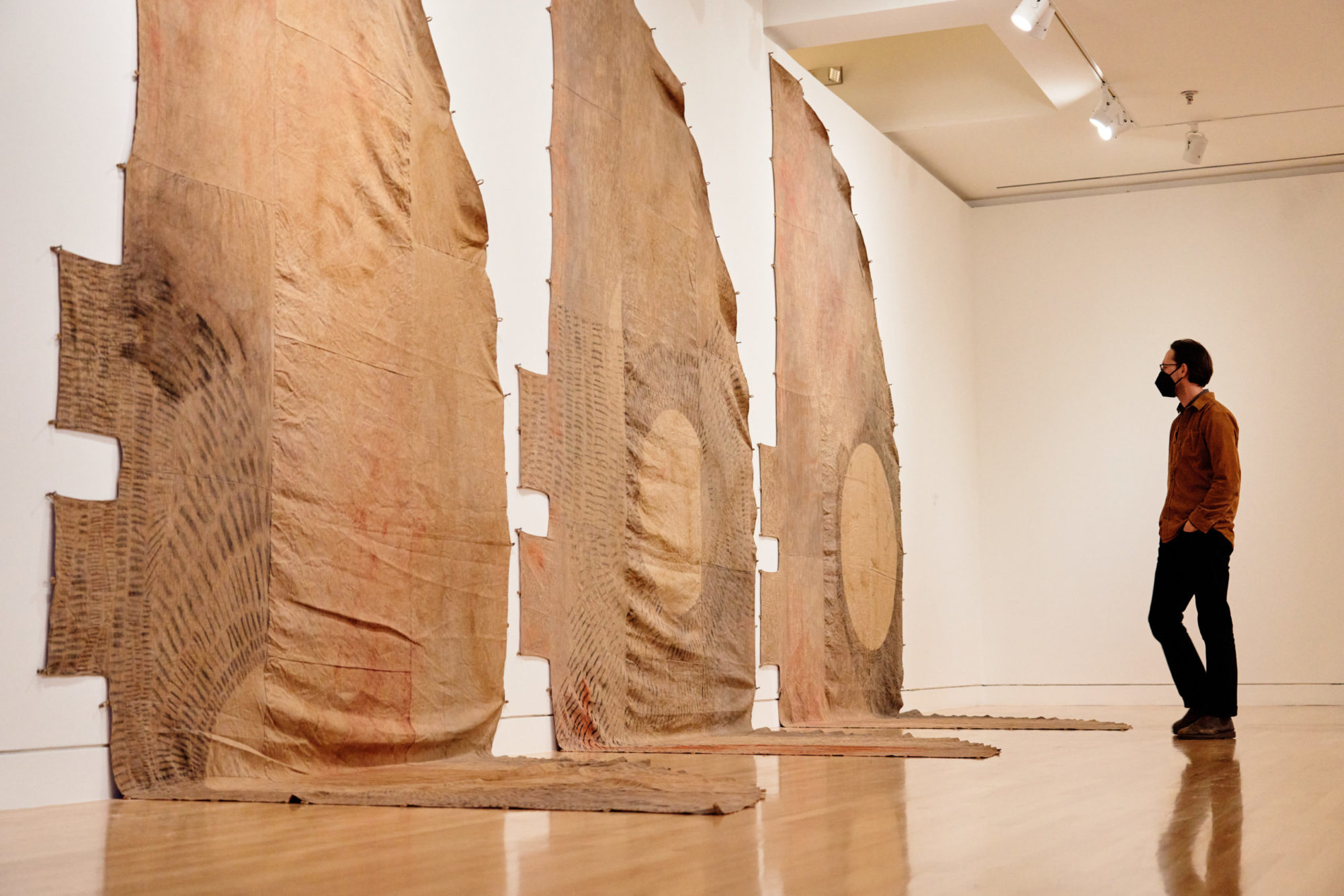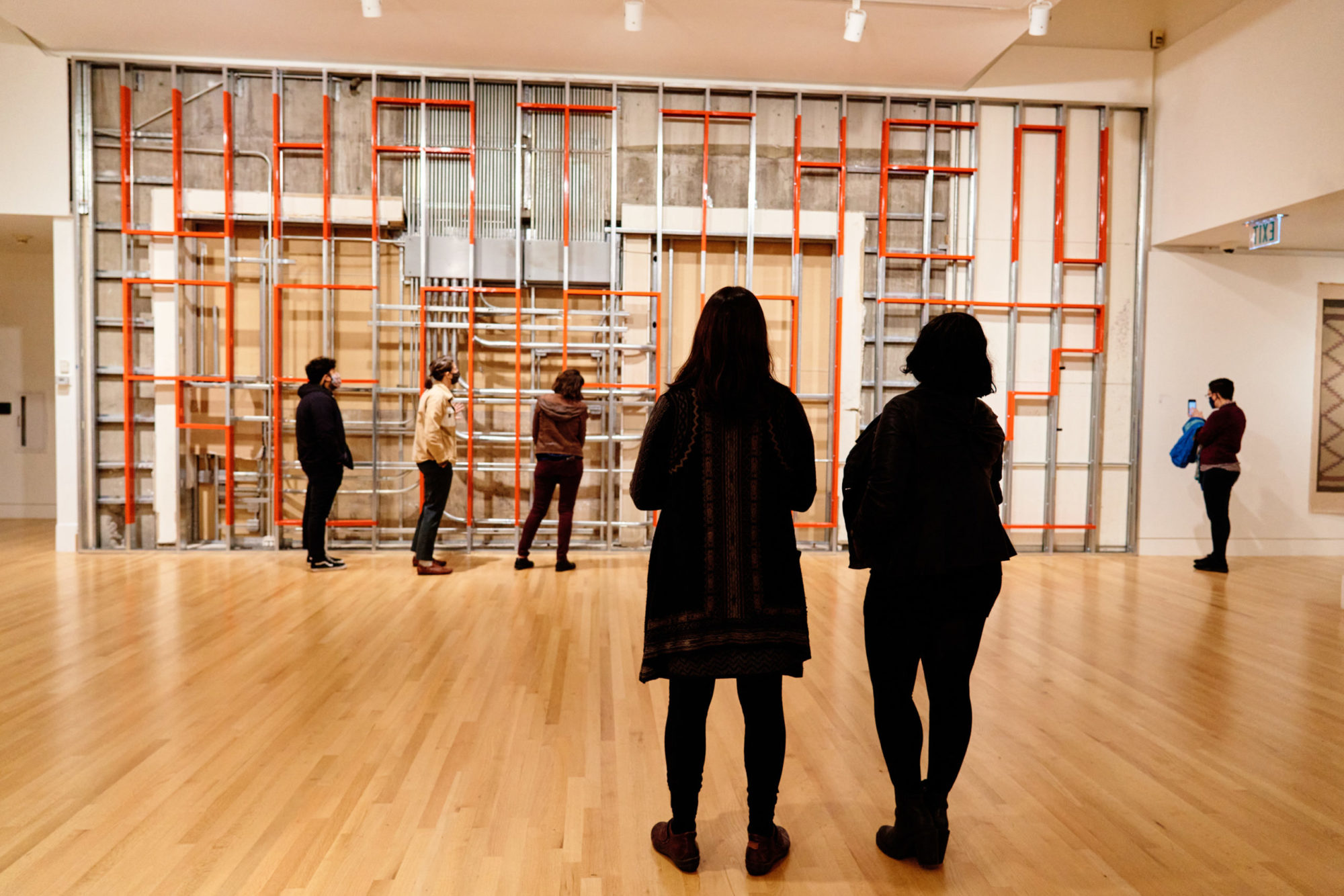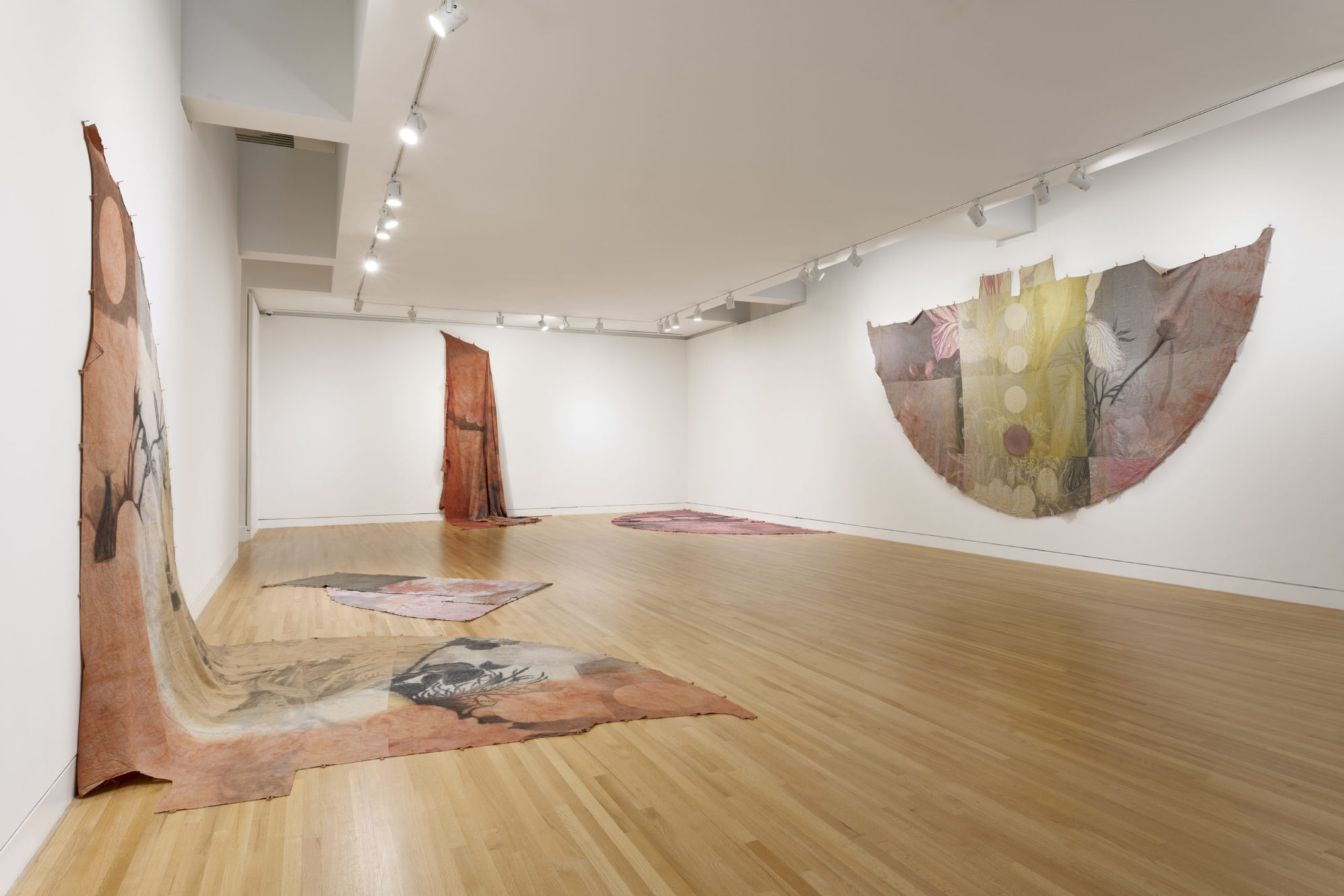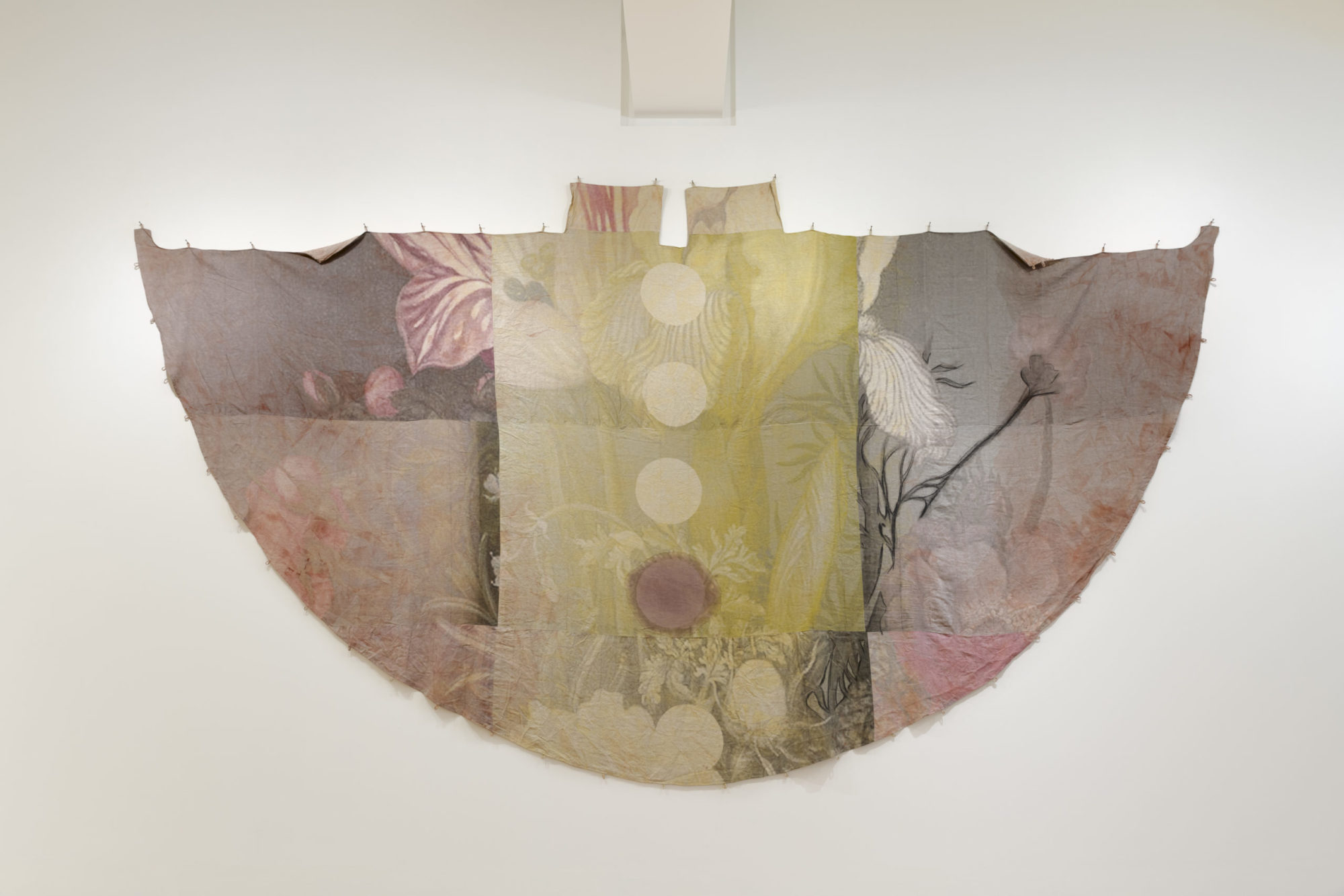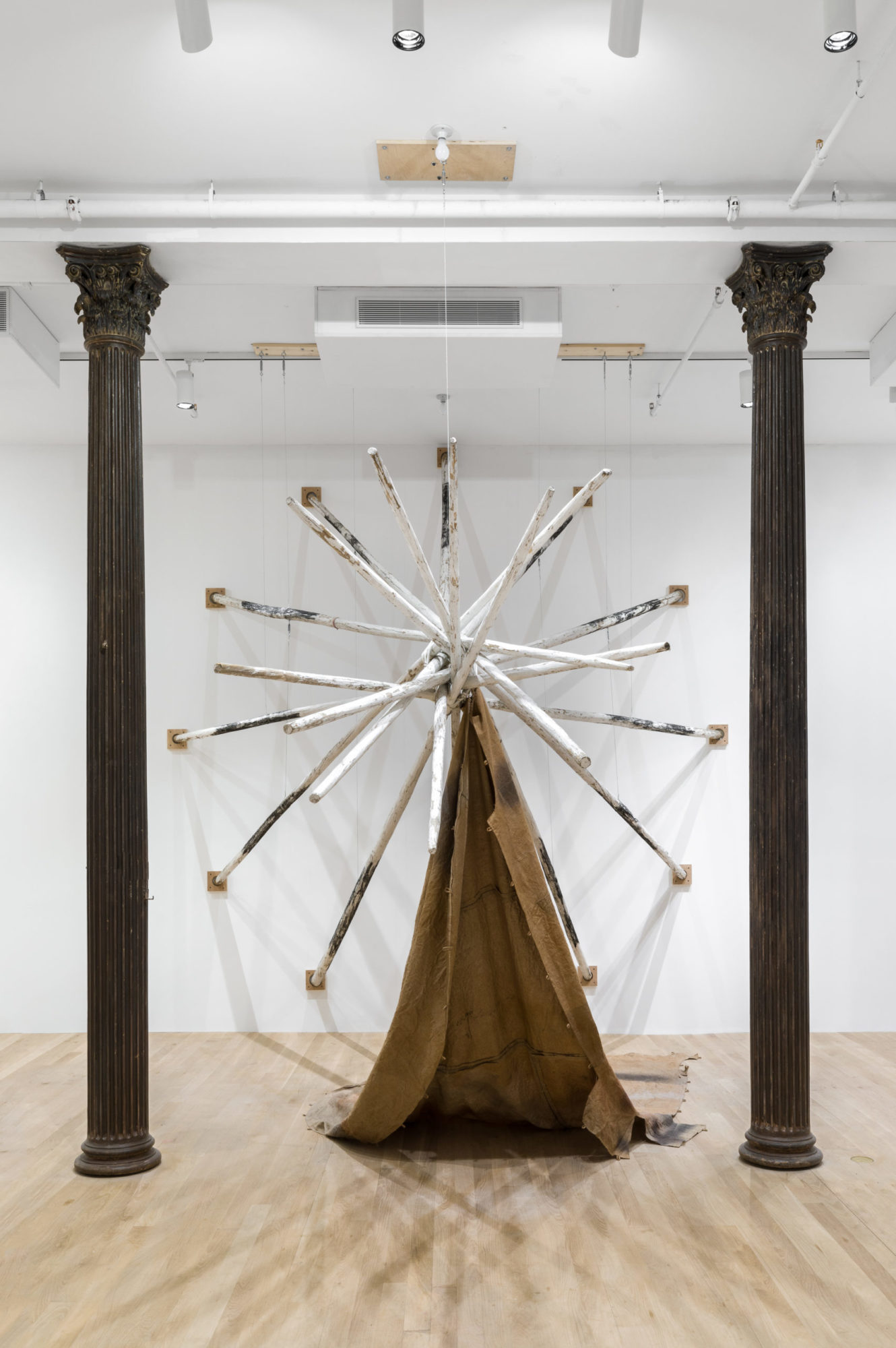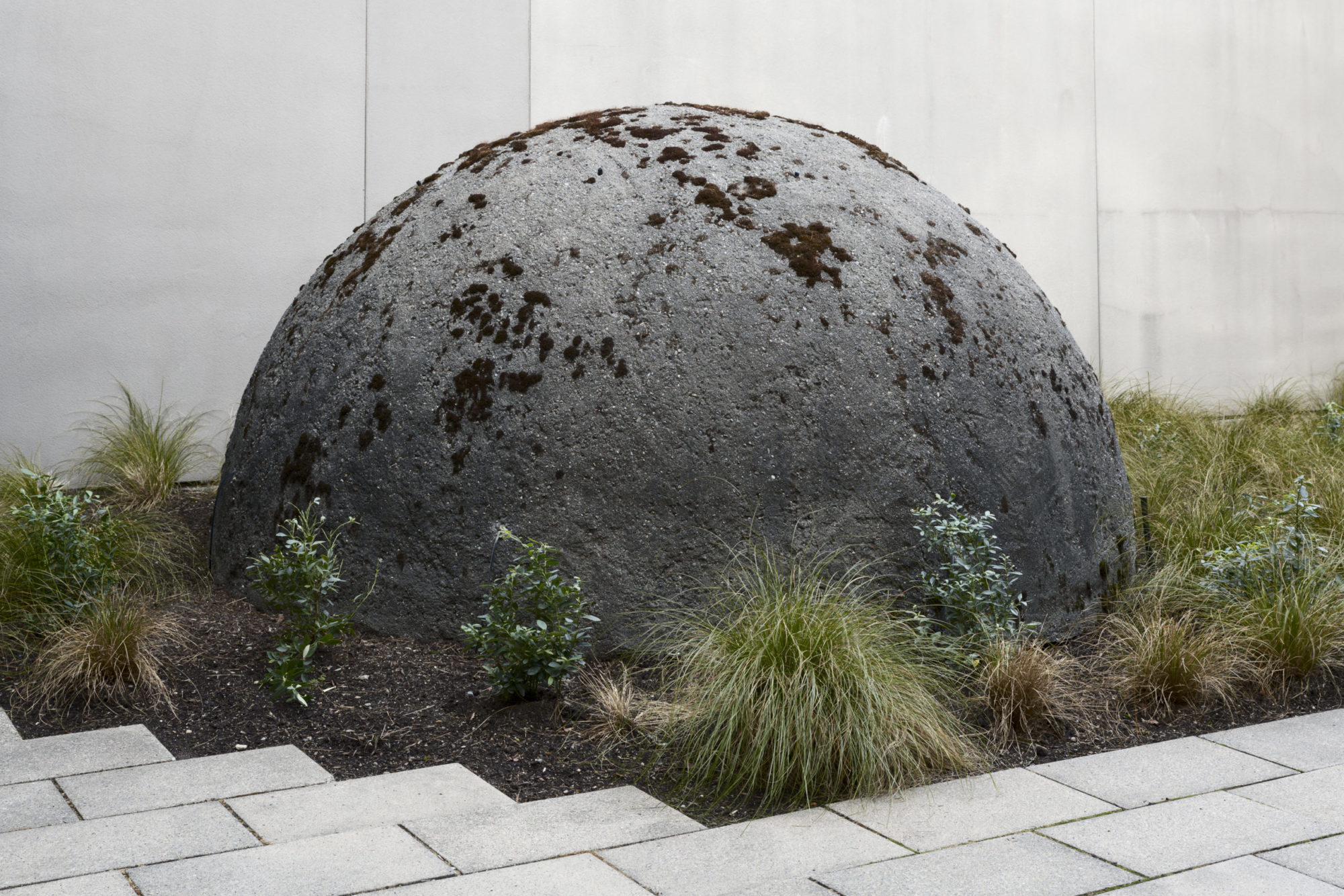
Duane Linklater, A blueberry garden for Seattle, installation view, 2021, blueberry bushes [photo: Jueqian Fang; courtesy of the artist, and Frye Art Museum, Seattle]
Duane Linklater: mymothersside
Share:
Far in the distance of a vast, snow-covered clearing, men dressed in North Face jackets approach a large, dark mass on the ground. Guns strapped to their backs, they cross the snow, cast in a vivid purple by the morning twilight. Rendered through the beautiful imperfections of this Super 16 mm silent film, the sun rises slowly over these men as they diligently dress, clean, and section the carcass of a moose. They carefully roll its pelt in plastic to protect it from the pooling blood. In what may appear mundane, Duane Linklater and Brian Jungen’s film, Modest Livelihood (2012), invites viewers to witness a ritual that is central to their Indigenous identities and the perseverance of Indigenous ways of living. The slow and meditative pace of the 50-minute film follows Linklater, Jungen, and Dane-zaa elder Jack Askoty as they hunt on Treaty 8 territory in northern British Columbia. The film’s title reflects the strain placed upon Indigenous hunters by treaties, negotiated more than 200 years ago, which state that hunting should not exceed the necessity of a “moderate livelihood.” Viewing these men, idle in their camp chairs, we contend with the present fact that the traditional practices to sustain themselves and their families are still regulated by the Canadian government.
mymothersside (September 18, 2021–January 16, 2022) is an expansive survey of Linklater’s practice on view at the Frye Museum of Art in Seattle, WA. Linklater is an Ontario-based, Omaskêko Cree artist whose practice involves interrogation of visual culture, language, material, and land to reveal alternatives to settler-colonial structures of knowledge and space. Consisting of film, sculpture, and installations produced within the last 10 years, mymothersside directly confronts the museum’s institutional structure and pedagogies with site-responsive, multimedia installations centered on often-appropriated symbols, such as the tepee. Beyond functioning as a traditional dwelling for Cree peoples, the tepee (mîkiwahp) is a cultural symbol that teaches and exemplifies sacred balance—of the self, of family, and of community. The tepee also embodies conflicting visual histories as a symbol used to conflate and erase diverse Indigenous cultures across the Americas. Using processes of construction, deconstruction, and shifting proximity, Linklater reveals and subverts the complex relationships between law and livelihood, between our bodies and the land, and between culture and commodity.
Duane Linklater, winter in america_no door_âkamenimok, installation view, 2020, digital print on hand-dyed linen (black tea, sumac, charcoal, cup-and-saucer ochre, iron-red pigment, dandelion), nails, 218 x 312 x 6 inches [photo: Rachel Topham Photography; courtesy of the artist, and Catriona Jeffries, Vancouver]
Duane Linklater, What Then Remainz, installation view, 2016/2021, disassembled wall(s), powder-coated steel, steel screws [photo: Toni Hafkenscheid; courtesy of the artist, and Mercer Union, Toronto, and Catriona Jeffries, Vancouver]
Duane Linklater, can the circle be unbroken 1-5, installation view, 2019, digital prints on Linen [courtesy of the artist and Frye Art Museum, Seattle]
What Then Remainz (2016 and 2021) is an installation involving the deconstruction of a permanent, floor-to-ceiling museum wall, to reveal a system of pipes, wires, and the building’s concrete skeleton. The wall has been replaced with new studs made of powder-coated steel that bears the text “what then remainz” in large red letters. The work quotes Supreme Court Justice Sonia Sotomayor’s 2016 remarks during the trial Dollar General Corporation v. Mississippi Band of Choctaw Indians, in which a split vote effectively voided the trial: “What then remains of the sovereignty of the Indians?” Within the context of the installation, the gesture to remove the museum wall reframes this question for the viewer. What is a cultural institution without its walls? Installed on the opposite wall of the gallery is dislodgevanishskinground (2019). Twelve painted poles protrude in a circular formation coalescing to form a sideways tepee. This large-scale sculpture is bound with rope, from which a swath of the tepee’s printed linen covering—which has been stained with black tea and blueberries—drapes the floor. Constructed with too few poles, and with her legs bare, this tepee does not represent a traditional lodging. Its rotated position, “dislodged” from the ground, evokes histories of mass displacement and broken treaties in the wake of colonization. Yet, within the seemingly permanent edifice of the museum, the tepee offers a contrasting cultural structure that is resilient, versatile, and transient.
Duane Linklater, Can the circle be unbroken 2, installation view, 2019, digital prints on linen [photo: Don Ross; courtesy of SOFT POWER, San Francisco, and Museum of Modern Art, New York]
Linklater’s works open an imaginative space to consider not only the limitations of the museum but the new possibilities that arise when museum walls are deconstructed, figuratively or literally. The exhibition forms a contemporary portrait of Indigenous life through subtle offerings of perseverance, adaptation, and growth, despite myths of extinction. This gesture is most evident in his multilayered explorations of materiality, as well as his use of objects and cultural symbols tied to life before first contact—and after it.
Within the installation The place I seek to go (2014), Linklater juxtaposes a stamped coyote pelt, steeped with histories of the fur trade, with a small-scale video displaying the various hand maneuvers the artist developed as a child to hide a damaged finger. The coyote, with its roaming spirit, and the boy with the damaged hand both demonstrate survivance and adaptation as they find new ways to navigate and live in a changing world. Engaging the possibilities of the present, Linklater’s A blueberry garden for Seattle (2021) requires the formation of a new interdependent relationship with the institution, one based on trust. Thus, the museum takes on the responsibility of caring for the plants for the exhibition’s duration.
Duane Linklater, dislodgevanishskinground, installation view, 2019, twelve painted tepee poles, steel cable, charcoal, rope, digital print on linen (black tea, blueberry extract, sumac dye, charcoal), 220 x 174 x 174 inches [photo: Daniel Pérez; courtesy of the artist, and Artists Space, New York City, and Catriona Jeffries, Vancouver]
This sprawling exhibition is rich with personal, historical, and cultural meaning that requires time and thought for an expansive concept of Indigeneity to unfurl. The material and conceptual complexities of Linklater’s works are so intricate that it is impossible to do justice to them within the limited space and form of a review such as this one. Linklater demonstrates a vast knowledge of art history, of film, and of modern music, offering many points of entry for viewers to explore. One of the most intriguing installations involves the display of reproduced objects from the collection of the Utah Museum of Fine Arts—ones created between 1875 and 1978, without clear authorship on record. Linklater reproduced uncredited Navajo textiles, printed on linen and hung on the walls, whereas masks and sculptural objects have been crudely reproduced with a 3-D printer in ABS plastic.
The UMFA installation (2015) was created as a commentary on ways that indigenous objects are historically generalized and under-researched in cultural institutions. The objects are presented here, out of context, and voided of their spirit. The pixelized texture of their digitally reproduced surfaces further obscures the hand of the unnamed maker(s). Within their new context at the Frye Art Museum, they read as anthropological—as a display not of assorted Indigenous artifacts but one showcasing their Western mishandling. Linklater puts on full, mirrored display the ignorance and violence of these institutions and their significant role in perpetuating the myth of Indigenous extinction.
TK Smith (he/him) is a Philadelphia-based curator, writer, and cultural historian. His writing has been published in Art in America, the Monument Lab Bulletin, and ART PAPERS, where he is a contributing editor.
